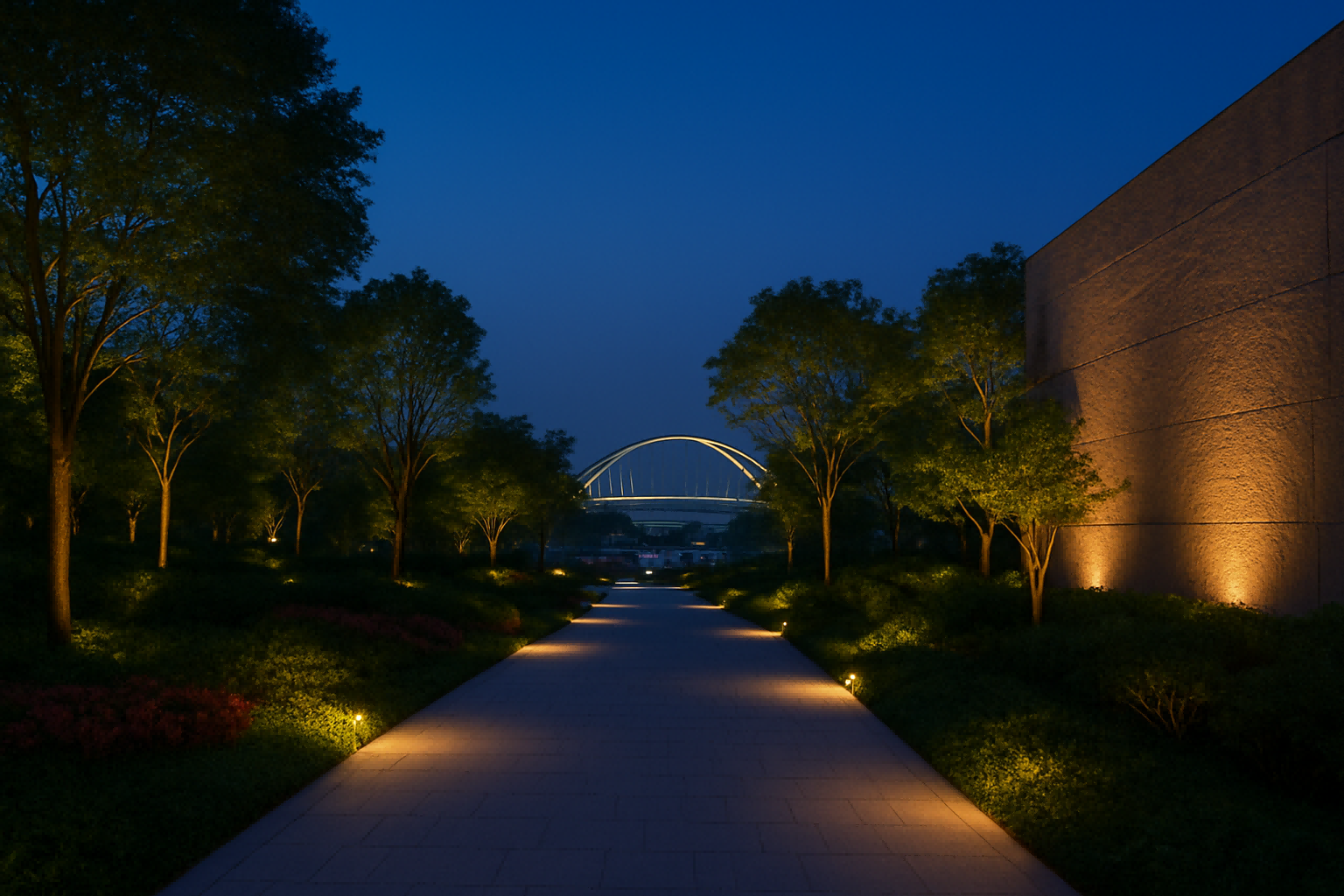Effective Solutions for Irregular Facade Lighting
A building facade is more than just an outer shell of glass, stone, or metal. It’s the face of architecture — a language of form, rhythm, and material that speaks to the city and its people. When that facade defies symmetry, bending and folding in unexpected ways, it challenges not only the engineer’s precision but also the lighting designer’s imagination. Each curve and edge becomes a dialogue between light and shadow, where illumination must adapt, interpret, and ultimately reveal the architecture’s hidden narrative.
But lighting an irregular facade is far from a simple technical task. The interplay of geometry, texture, and reflection can easily create uneven brightness, glare, or visual confusion if handled without care. Poorly placed fixtures may flatten the structure’s depth, distort its proportions, or waste valuable energy. Conversely, a well-orchestrated lighting design can breathe coherence into complexity — transforming fragmented surfaces into a cohesive nighttime composition that celebrates the building’s uniqueness and the designer’s ingenuity.
When a facade is no longer flat and straight, but instead features curves, folds, perforations, or free-form shapes, lighting transcends mere illumination. It becomes a creative interplay of art and technology—where light interprets form, emphasizes architectural rhythm, and maintains visual balance.
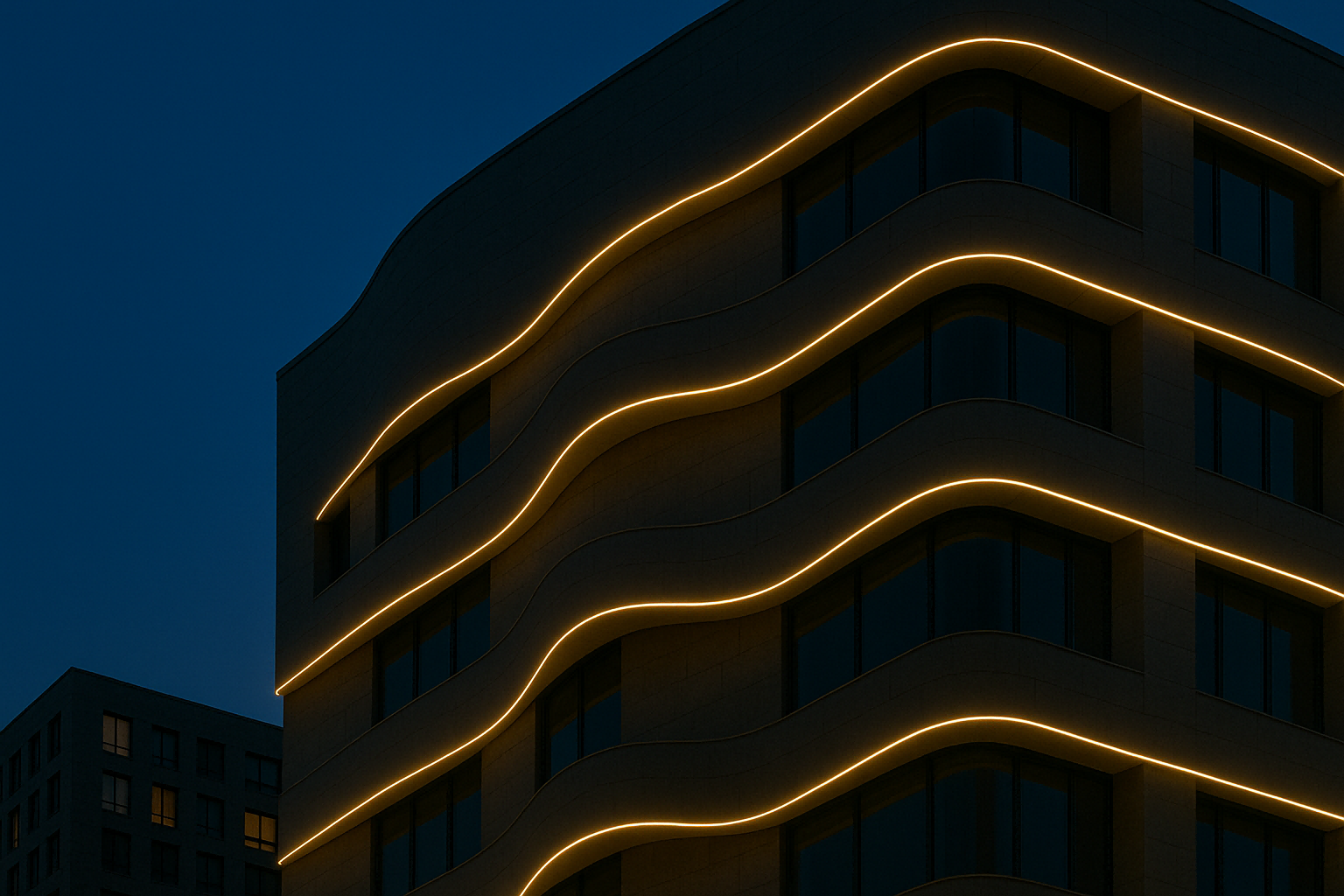
1. Understanding Irregular Facades lighting
1.1) What Is an Irregular Facade Lighting
Irregular facade is not a strict architectural term — it simply describes any building surface that breaks away from the conventional flat and orderly wall design. In other words, it refers to facades with varied geometry, texture, or depth that make light behave in unpredictable ways. Understanding this physical form is the foundation of all lighting design decisions that follow.
Common examples of irregular facades include:
Curved or wave-shaped facades: such as stadiums, art centers, or malls with smooth, flowing surfaces.
Residential towers with projections and recesses: where balconies, bay windows, or shading panels create strong light and shadow contrasts.
Decorative facades with patterned panels: using diamond, triangular, or folded metal panels to produce dynamic visual textures.
Facades with heavy shading structures: such as offices featuring deep louvers or cantilevered sunshades that add rhythm and depth.
In short, irregular facades turn a simple lighting task into a creative and technical challenge — one that demands precision, adaptation, and a deep understanding of how light interacts with form.
1.2) Why Irregular Facades Make Lighting Challenging
When a facade is no longer flat, lighting complexity rises sharply. The challenges usually appear in four key areas.
First, uneven illumination — curves, folds, and angles cause light intensity to fluctuate dramatically across the surface, creating patches of brightness and shadow. Second, glare and reflection — glossy or metallic finishes can bounce light directly into viewers’ eyes, reducing comfort and visual clarity. Third, installation difficulty — irregular geometry often requires custom brackets, pre-bent housings, and modular assemblies to ensure proper alignment. Finally, maintenance complexity — concealed wiring, recessed fixtures, and limited access points make inspections and repairs time-consuming and costly.
These factors rarely exist in isolation. They interact, amplifying one another, which means successful irregular facade lighting must be an integrated effort — where design aesthetics, structural engineering, and intelligent control systems are developed hand in hand.
1.3) Purpose of This Guide and Target Audience
Irregular facade lighting often collapses under the weight of its own complexity — beautiful concepts, yet poor execution. This article aims to close that gap. It is written for professionals who navigate the full spectrum from design to delivery: architects defining intent, lighting designers shaping atmosphere, and engineers ensuring precision.
You’ll find a balanced approach here — one that connects artistic vision with technical logic. The objective is not just to “make it bright,” but to achieve visual harmony, structural feasibility, and long-term reliability. Each idea shared here is drawn from real project experience, tested against the challenges of installation, control, and maintenance.
2. Site Survey and Preliminary Preparation
2.1) Project Background and Site Understanding
In any outdoor facade lighting project, a site survey is more than just measuring and recording—it is the starting point for understanding the relationship between space and light. Surveys should approach the site from both macro and micro perspectives.
At the macro level, analyze the urban context, surrounding lighting conditions, architectural style, and pedestrian or vehicle circulation. At the micro level, assess the facade materials, reflective properties, available mounting structures, and electrical access conditions. This initial information forms the foundation for subsequent lighting design, fixture selection, and installation planning, ensuring that decisions are well-informed and site-specific.
2.2) Technical Assessment and System Compatibility
The core goal of technical assessment is to ensure that the design concept is both implementable and maintainable. On-site inspections should include power supply systems, electrical wiring paths, and control signal routing. Designers must decide whether to adopt centralized or zoned control, and select appropriate protocols such as DMX or DALI, as well as determine whether to use single-color or RGBW lighting systems.
Additionally, confirming fixture compatibility with control systems early prevents issues like signal interference or communication delays during commissioning. On-site light measurement and simulation help verify that design parameters align with actual reflective conditions, optimizing luminous flux, color temperature, and beam angles. This ensures the final result meets both aesthetic intent and energy efficiency standards while maintaining safety compliance.
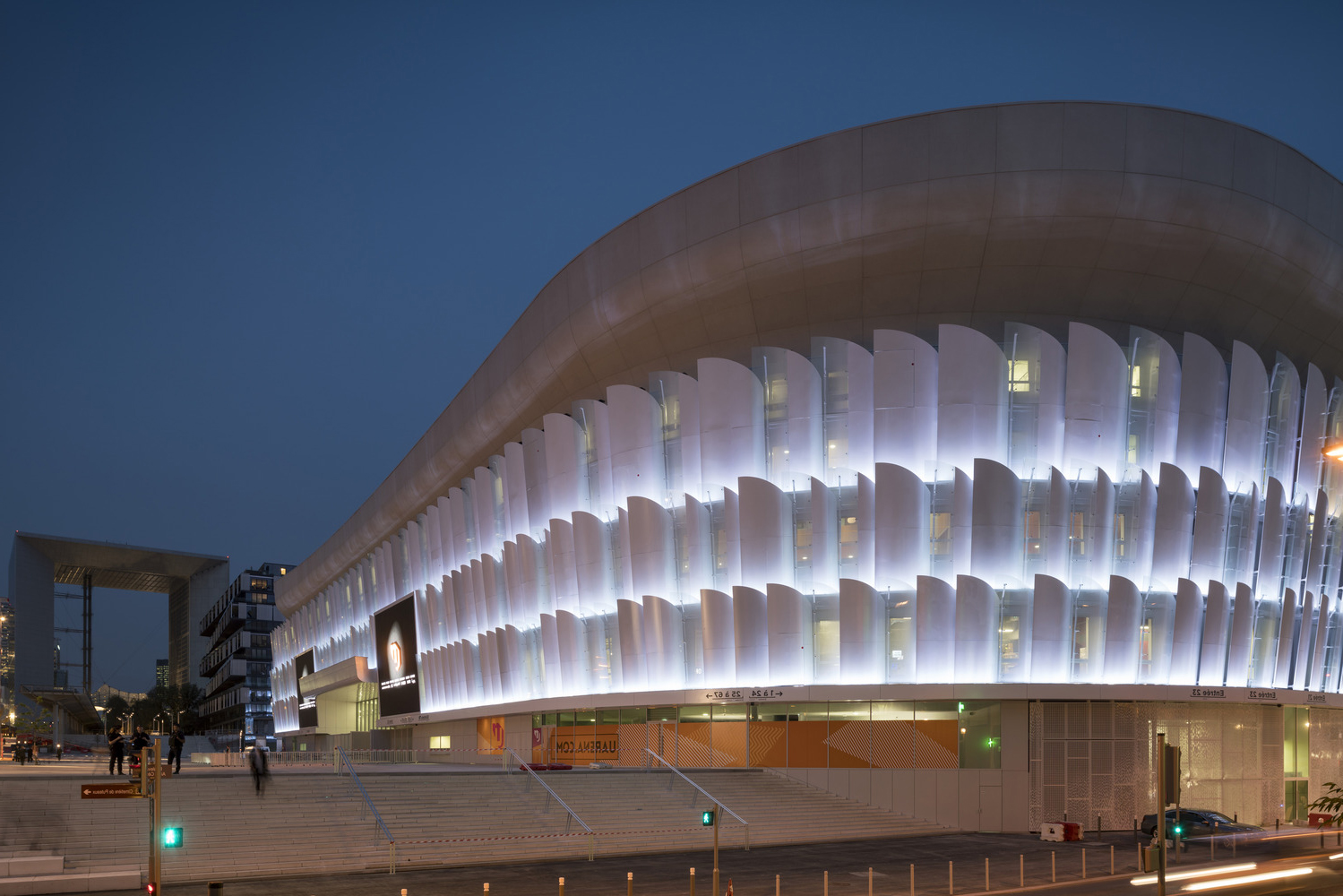
2.3) Design Integration and On-Site Validation
Once technical compatibility is confirmed, the project moves into the design integration and validation phase. The focus here is to translate conceptual lighting ideas into real-world results.
Designers can conduct on-site preliminary simulations using handheld fixtures, temporary mounts, or sample lights to observe variations in angle, color temperature, and brightness. These hands-on tests provide practical insight and guide subsequent design optimization.
On-site validation should also evaluate installation feasibility, including structural strength, wiring paths, waterproofing, and maintenance access. Close coordination with contractors, clients, and lighting suppliers ensures that fixture layout, installation angles, and cabling plans are not only accurate on paper but also safe and practical in real-world conditions.
3. Design Strategy and Lighting Concept Development
3.1) Translating Design Intent into Measurable Lighting Goals
When facing an irregular facade, lighting design becomes an art of translation—turning complex architectural geometry into readable light patterns. Every beam of light must have a reason, a target, and a measurable outcome. The design process begins not with brightness but with clarity: what story should this facade tell at night, and how can light express its architectural rhythm?
A successful architectural lighting concept starts by defining measurable goals. Instead of vague ambitions like “make it stand out,” designers translate intentions into quantifiable targets. For instance, a “contour emphasis” can be expressed as a visible edge brightness of 8–15 lux depending on viewing distance, while “texture enhancement” might mean achieving a 20–40% local contrast increase through grazing light. These parameters form the backbone of a design brief and become shared language between designers, engineers, and clients. Clear metrics prevent endless subjective revisions and make both tendering and final commissioning more precise.
3.2) Hybrid Lighting Strategies for Irregular Facades
Lighting a complex facade often demands a hybrid approach—combining linear, wall-wash, and point sources to balance uniformity with depth. Linear fixtures elegantly outline edges and seams, giving architectural definition. Wall-washers spread soft light over wide surfaces, revealing material tone and rhythm. Point or pixel lights add accent, animation, or movement.
The real craft lies in layering: outlining the structure, shaping the plane, then activating the detail. Even within tight budgets, this layered strategy ensures flexibility and gradual upgrade paths without sacrificing the integrity of the concept. The interplay between different fixture types allows the facade to appear balanced yet dynamic—an essential principle in professional facade lighting design.
3.3) Balancing Color Temperature, CRI, and Brightness Hierarchy
Color temperature and brightness hierarchy define the building’s night-time personality. Warm white (2700–3000 K) flatters stone and brick, preserving their tactile warmth; neutral to cool tones (3500–4000 K) amplify the modern clarity of glass and metal. A color-rendering index above 80 is generally suitable, while facades with artistic or colorful materials should aim for CRI 90 or higher.
Luminance should not be uniform—entrances and human-scale zones deserve higher levels, while upper facades and distant views require softer transitions. This hierarchy gives the composition visual rhythm and emotional depth, ensuring the architectural lighting aligns with both the material character and the city’s nightscape identity.
3.4) Pixel Lighting: The Balance Between Creativity and Practicality
The question of pixelization sits at the frontier between creativity and practicality. Pixel lighting brings motion graphics and storytelling potential to the facade, but it also multiplies complexity in control, cabling, and maintenance. The decision should hinge on purpose and perception: is dynamic content essential, or will subtle gradients suffice?
Viewing distance, pixel density, and long-term maintenance capacity all inform this judgment. When uncertain, designers can prepare for the future by reserving power and data interfaces, adopting modular control systems that allow partial upgrades later. This forward-thinking approach keeps the facade lighting adaptable as technology evolves.
Ultimately, designing for an irregular facade is about orchestrating order within complexity. By grounding artistic intention in measurable logic and technical foresight, we transform unpredictable surfaces into luminous compositions that communicate both precision and poetry—embodying the true spirit of modern outdoor lighting design.
4. Lighting and Optical Selection for Facade and Outdoor Projects
4.1) Choosing Linear and Flexible LED Strips
LED linear lights are essential for outlining architectural contours and narrow gaps. When selecting models, consider the bending radius (rigid vs. flexible types), diffuser quality to eliminate pixel spots, and the luminaire’s heat dissipation and driving method.
For curved facades with a radius smaller than 0.5 m, flexible LED strips or segmented rigid fixtures with elastic connectors are preferable. The aluminum profile must provide efficient heat conduction and precise surface fitting—prototype testing in the factory is strongly recommended before mass production to ensure accuracy and visual consistency.
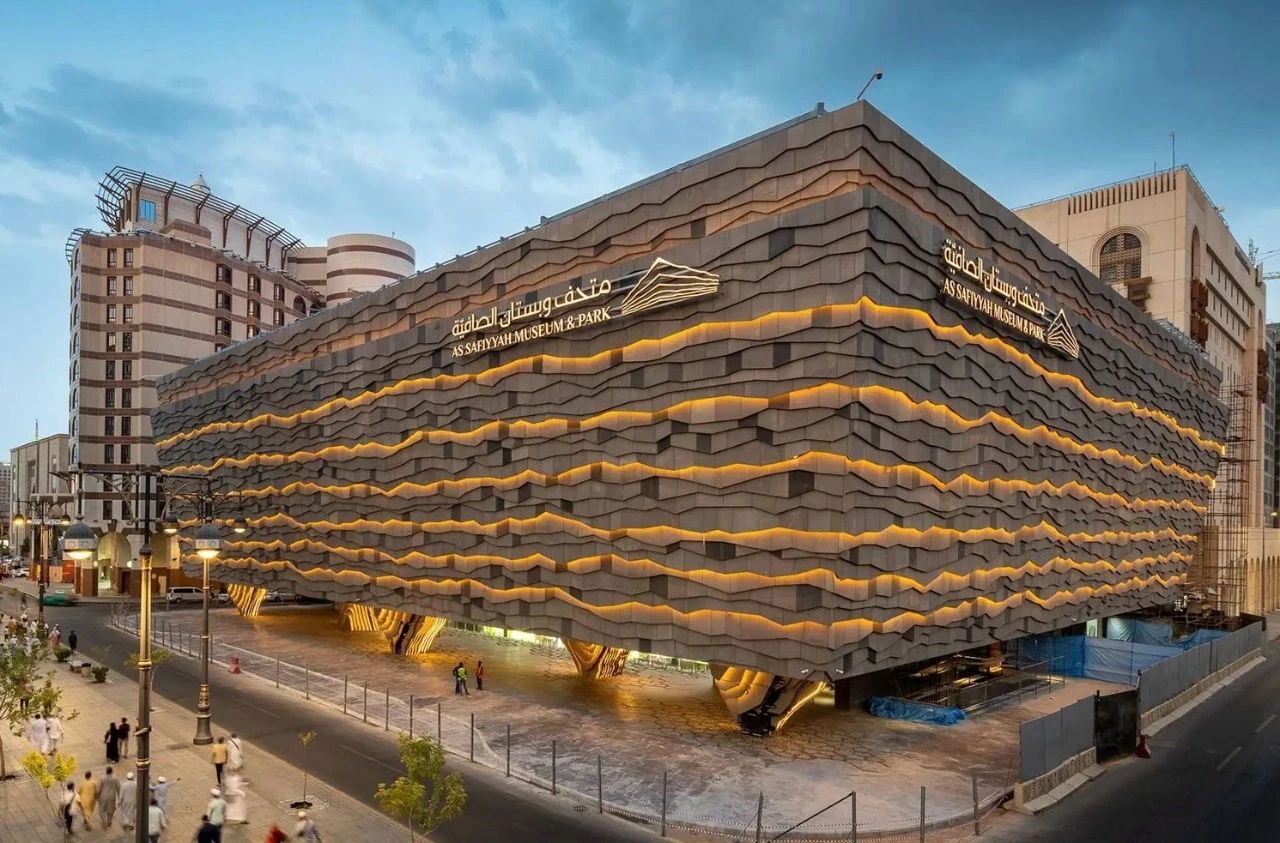
LNJAMI’s flexible LED strips and modular linear profiles are designed for curved or free-form facades, offering precise bending radii, high CRI, and robust thermal management. Tested in-house before delivery, these products ensure both visual continuity and installation reliability.
4.2) Wall Washer Light and Beam Angle Selection
Wall washer lights define the surface texture and brightness balance of facade illumination. A practical rule is to calculate the beam angle based on the ratio of wall height to projection distance. For instance, to evenly light a 6 m facade from a 12 m distance, the ideal beam angle is roughly 28° (2×arctan(3/12)), making 30°–45° optics suitable for on-site fine-tuning.
To reduce uneven brightness bands, choose adjustable mounting brackets that allow gradual tilt calibration during installation. Consistent alignment is key to achieving smooth, professional wall-washing results in outdoor lighting projects.
4.3) Pixel Light and Control Engineering
In pixel lighting systems, pixel density and power distribution directly determine image resolution and color consistency. For close viewing (<10 m), a density ≥ 30 px/m ensures sharp effects; for mid-range (10–30 m), 10–30 px/m is sufficient; for long-distance observation, lower density can save cost and power.
Power supplies should be installed close to the fixtures to minimize voltage drop and prevent color deviation. Ethernet-based control protocols such as Art-Net or sACN are recommended for large-scale facade lighting or interactive pixel installations, offering high stability and scalability.
4.4) Optical Accessories: Lenses, Diffusers, and Louvers
Anti-glare louvres or recessed housing are often more effective at eliminating direct glare than simply reducing brightness. Diffusers help smooth out pixel visibility but slightly reduce luminous efficiency, while lenses are used to shape focused beams. The right optical combination must balance uniformity, brightness, and visual comfort. Always perform comparative tests with sample lights before finalizing the optical scheme—this step greatly affects the aesthetic and functional outcome of architectural lighting.
4.5) LED Packaging and Thermal Management (SMD vs. COB)
SMD and COB represent two distinct LED packaging strategies. SMD LEDs offer superior flexibility and pixel-level control, ideal for dynamic or curved installations. COB LEDs, on the other hand, deliver higher lumen density and uniformity, making them suitable for facade floodlighting and large-area illumination.
However, COB fixtures require robust heat dissipation systems—consider aluminum substrates, thermal pastes, or integrated heat sinks. In architectural applications, the choice between SMD and COB should align with both lighting effect and long-term reliability.
4.6) Ingress Protection and Weather Resistance
Outdoor facade luminaires must meet at least IP65 for dust and water protection. For ground-level or high-humidity areas, IP67 or IP68 is strongly recommended. In coastal or corrosive environments, opt for 316 stainless steel or fixtures with enhanced anti-corrosion coatings.
All materials and corrosion-resistance intervals should be clearly specified in the lighting design documentation to ensure maintenance predictability and project longevity.
5. Structural and Installation Solutions for Outdoor Lighting
5.1) Customized Brackets and Prefabricated Aluminum Profiles
Brackets are not temporary accessories—they determine how precisely the lighting fixtures align with the facade and how efficiently they dissipate heat.
The best practice is to perform 3D scanning or on-site measurement to produce a prototype, then complete trial assembly of aluminum profiles and brackets in the factory. Confirming fit and heat dissipation performance before mass production ensures consistency and reliability.
Modular segmentation also helps shorten on-site installation time and improve overall build quality, which is essential for complex facade or bridge lighting projects.
5.2) Fixing Methods and Thermal Expansion Control
Buildings expand and contract with temperature changes. To accommodate this, bracket designs must allow slight structural flexibility. Include anti-loosening mechanisms such as spring washers or double-lock nuts to prevent vibration-induced failure.
Where two materials meet, integrate flexible joints to prevent stress concentration—this significantly extends the service life of both the structure and lighting fixtures.
5.3) Cable Routing, Waterproof Connectors, and Maintenance Access
Maintenance efficiency should be considered as early as the design phase. Place drivers and replaceable components in accessible zones, avoiding hidden joints in confined spaces.
All outdoor connections should use IP68-rated waterproof connectors and include drainage or ventilation features to prevent condensation buildup inside sealed units. A well-planned cable routing system not only enhances durability but also simplifies long-term maintenance for outdoor lighting installations.
5.4) Benefits of Pre-Assembly and Segmented Hoisting
Performing pre-assembly and lighting tests on the ground—including power-up and beam alignment—significantly reduces adjustment time and safety risks at height. This approach allows teams to identify mismatched components or structural incompatibilities early. Once verified, the prefabricated modules can be lifted and mounted in segments, achieving both precision and efficiency in large-scale facade lighting installation.
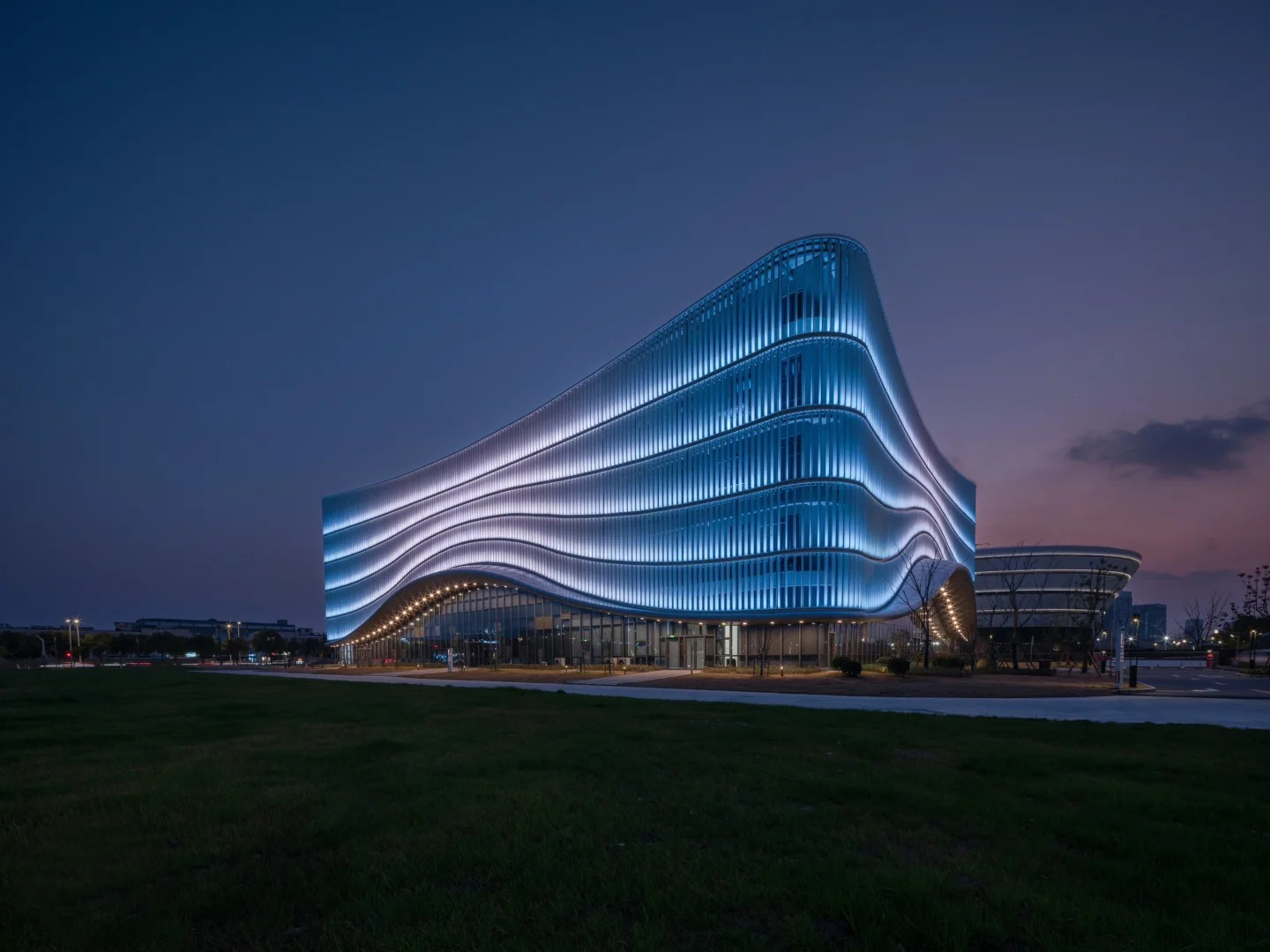
6. Lighting Control System and Visual Realization
6.1) Hierarchical Control: Monochrome, Zoning, and Pixel-Level
Designing the hardware is only half the story; the true magic of facade and outdoor lighting emerges through a well-planned control system. A modern installation should operate on three hierarchical layers:
Base white lighting handles on/off switching and dimming, typically using reliable protocols such as DALI or centralized drivers.
Zonal or scene-based control manages different lighting moods for everyday use, festivals, or special events.
Pixel-level effects utilize Ethernet-based protocols like Art-Net or sACN to achieve dynamic patterns, animations, and intricate color transitions.
This layered approach ensures both immediate usability and long-term flexibility for future upgrades.
6.2) Protocol Selection, Network Planning, and Compatibility
Choosing the right control protocols is critical for current performance and future-proofing. DALI offers mature, stable solutions for white-light energy management, while Art-Net and sACN are ideal for pixelized or animated lighting effects.
Network design should incorporate redundancy, remote access, and firewall security to ensure reliable operation. Planning these elements early prevents future downtime and simplifies maintenance of large-scale outdoor or facade lighting projects.
6.3) Scene Programming, Scheduling, and Interactive Logic
A mature control system goes beyond simple scene switching. It should manage schedules, automation, and environmental interaction.
We recommend defining at least four programmable modes — Daily, Energy-Saving, Event, and Emergency. These should integrate with light sensors, astronomical clocks, and the building’s BMS (Building Management System) to synchronize lighting behaviors.
This synergy delivers both expressive visual effects and intelligent energy efficiency.
6.4) On-Site Commissioning and Color Calibration Workflow
Commissioning is not just about turning the lights on. Each lighting zone should be fine-tuned in real conditions, particularly from key viewing points.
Use illuminance and color temperature meters to measure and record actual data. Export and store the final configuration files as “reference truth values” for future maintenance or troubleshooting.
Proper calibration and documentation ensure consistent color, brightness, and synchronization across the entire lighting installation.
LNJAMI provides integrated control solutions compatible with DALI, DMX, Art-Net, and sACN protocols, enabling hierarchical lighting control from basic white lighting to full pixel-level dynamic effects. Our engineers handle programming, scene setup, and on-site commissioning, ensuring that design intent is faithfully realized.
7. Optical Challenges and Glare Control
7.1) Glare Assessment and Visual Testing
Glare is one of the most critical factors in outdoor and facade lighting, as it directly impacts visual comfort and overall aesthetic perception. Quantitative metrics like UGR (Unified Glare Rating) provide a standardized measure of brightness contrast, but they cannot fully capture how humans perceive light in complex outdoor environments.
During installation, it is recommended to begin at low luminance levels and gradually increase intensity, observing the scene from multiple key viewpoints—pedestrian level, mid-distance, and far-view axes. Photographic documentation from each viewpoint, combined with on-site subjective assessment, allows designers to verify whether bright spots, reflections, or hotspots interfere with the intended visual effect.
In addition, consider material properties and facade texture during glare evaluation. Highly reflective glass, polished metal, or smooth stone can intensify glare, requiring adjustments in fixture placement, optical accessories, or dimming curves to maintain comfort while preserving the intended visual drama.
7.2) Using Louvers and Proper Mounting Depth
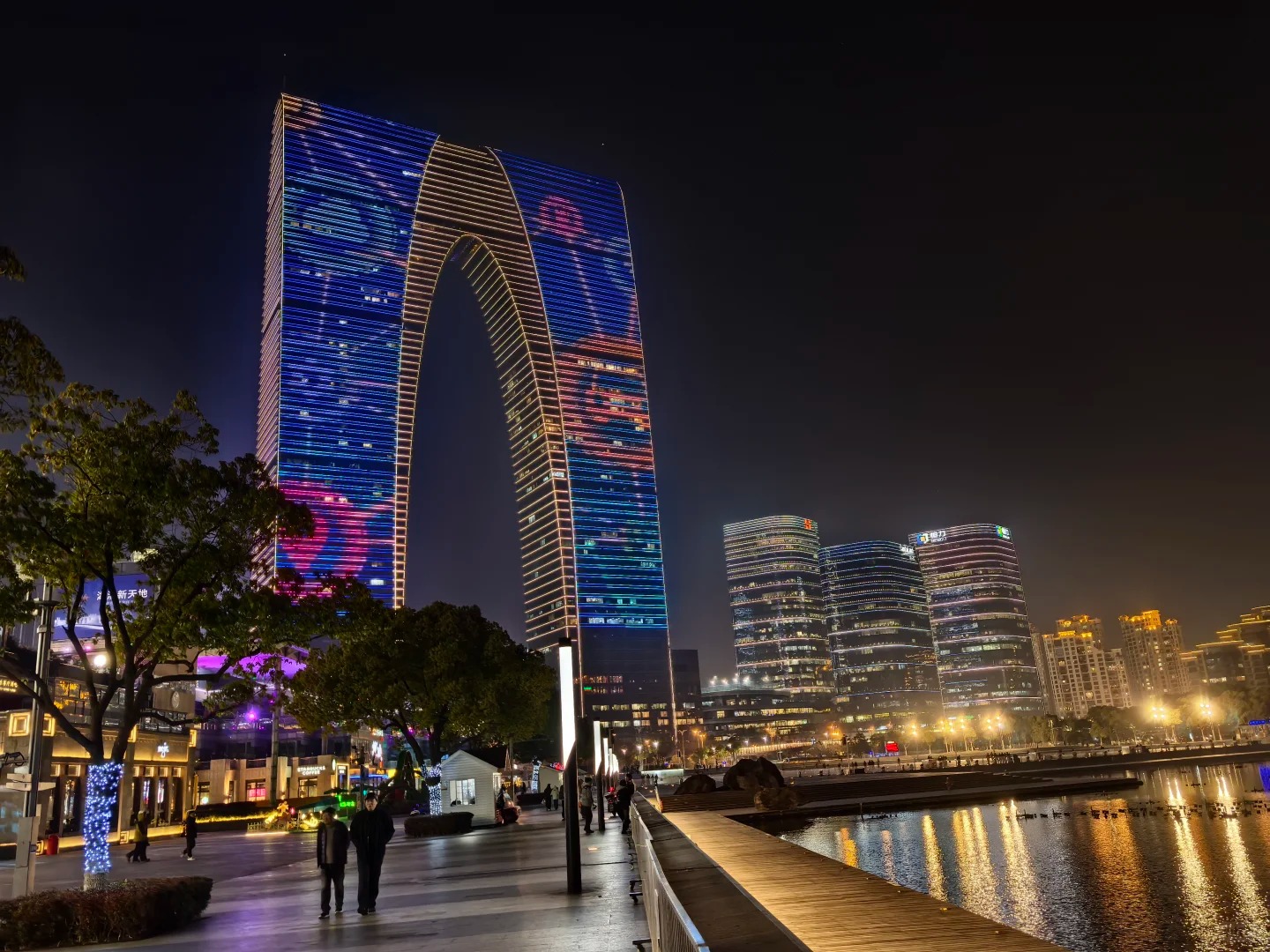
Louvers, baffles, and fixture recessing are essential tools for controlling direct glare without diminishing the perceived depth and layers of the facade lighting. Properly designed louvers direct light away from observers’ lines of sight, while maintaining enough illumination for architectural emphasis.
However, achieving the right balance is critical. Excessive recessing can trap heat, reduce cooling efficiency, and complicate maintenance access. Therefore, designers should evaluate each fixture’s thermal requirements, glare mitigation, and serviceability simultaneously. In some cases, modular louvers or adjustable shields allow in-field fine-tuning to adapt to subtle architectural variations.
7.3) Optimizing Beam Angles
Lighting irregular or curved surfaces poses additional optical challenges. Single long-throw wall washers often result in uneven brightness, hotspots, or projection distortion. A more effective strategy is to divide the facade into multiple segments, using short-throw, narrow-angle fixtures to create gradual transitions of light across curves and folds.
During installation, adjustable mounting brackets are crucial for fine-tuning angles and beam alignment. By combining careful segmentation, calculated beam angles, and on-site adjustment, designers can ensure consistent illuminance, visual layering, and architectural definition across the entire surface.
8. Maintenance, Acceptance, and Lifecycle Cost (LCC)
8.1) Practical Approaches to Maintainability
Designing for maintainability from the earliest stage can significantly reduce long-term costs. Position drivers, power supplies, and connectors in easily accessible locations. Use modular fixtures to enable quick replacement of individual units, and provide service access points and safe operation platforms for maintenance personnel.
Early consideration of maintenance not only reduces downtime but also ensures consistent lighting performance throughout the lifespan of the project. Attention to these details in the design phase often saves both money and operational headaches over the long term.
8.2) Acceptance Criteria and Testing Checklist
A thorough acceptance process ensures that the installation meets both design intent and contractual requirements. Recommended practices include:
Measuring illuminance and uniformity at key viewing points
Verifying color temperature consistency and color rendering (CRI)
Testing all control scenes and automation functions
Conducting waterproofing and environmental stress tests
Checking structural stability and proper fixture mounting
Ensuring documentation completeness
Standardizing the acceptance checklist as a contractual deliverable minimizes disputes and provides a clear reference for future maintenance or modifications.
8.3) Lifecycle Cost Estimation and Decision Support
When presenting proposals to clients, it is important to go beyond initial installation costs. Include annual energy consumption, expected maintenance expenses, and replacement cycles in the estimate.
Often, a slightly higher upfront investment—such as higher-quality materials or modular design—can pay for itself within 5–10 years through reduced maintenance requirements and lower replacement frequency. Incorporating Lifecycle Cost (LCC) analysis into the design discussion helps stakeholders make informed, sustainable decisions while balancing aesthetics, performance, and long-term operational efficiency.
9. Case Studies and Practical Approaches
9.1) Curved Glass Facades
For highly reflective or mirror-like glass surfaces, the preferred approach is to combine shallow-recessed flexible linear lighting with wide-beam wall washers. Bright points that produce strong reflections should be controlled with louvers or reduced intensity to maintain both architectural contours and low glare.
During on-site commissioning, special attention should be paid to reflective hotspots. Adjustments to color temperature or the addition of diffusers may be necessary to achieve a balanced visual effect. This method ensures that even highly reflective facades retain depth and clarity at night.
9.2) Parametric Metal Skins and Pixelized Lighting
Parametric metal facades are ideal candidates for pixel-level illumination, but several practical considerations apply. Pixel strips should be modular and have power supplies located nearby to avoid voltage drop and color inconsistency.
To reduce flicker and visual fatigue caused by reflective surfaces, use low-frequency LED drivers and implement fade-in/fade-out transitions and contrast limitations in software. This approach allows dynamic and visually comfortable effects without overwhelming observers.
9.3) Perforated or Textured Surfaces
Perforated or textured facades benefit from a combined point-light and backlight strategy. Point lights emphasize holes, nodes, or surface details, while low-angle wall washing or backlighting fills in the overall texture.
Adding diffusive materials helps avoid excessively bright glare points from perforations, ensuring the light and shadow interplay remains subtle yet expressive. This method enhances the richness of facade lighting textures and creates a layered, visually engaging nightscape.

10. Practical Tools and Replicable Checklists
Maintaining consistency and quality across multiple facade lighting projects is much easier when standardized tools are applied. The most effective approach is to formalize survey forms, fixture selection templates, and acceptance checklists into replicable project resources.
Survey forms: Record essential on-site data such as surface curvature, material type, mounting points, and available power sources. By quantifying these conditions early, designers and engineers can make informed lighting choices and minimize surprises during installation.
Fixture selection templates: Structure key parameters like fixture model, IP rating, color temperature, beam angle, and driver type. Templates allow quick comparison of options, streamline procurement, and ensure all design decisions are well-documented.
Acceptance checklists: Standardized checklists confirm that deliverables meet project specifications. They include verification of illuminance, uniformity, color consistency, control functionality, and structural integrity. Using checklists as part of the contract or handover documentation reduces disputes and facilitates long-term maintenance.
By adopting these replicable tools, teams can accelerate project delivery, ensure consistent quality across different sites, and make it easier to train new personnel or replicate successful lighting strategies.
Conclusion: Mastering Irregular Facade Lighting
Lighting an irregular facade is a unique blend of artistic vision, technical precision, and practical foresight. From the initial site survey and technical assessment to design integration, optical selection, control system planning, and on-site commissioning, every step demands careful coordination and informed decision-making.
Irregular surfaces—whether curved glass, parametric metal skins, or perforated textures—challenge designers to balance uniformity, contrast, glare control, and visual rhythm. By adopting hybrid lighting strategies, modular fixtures, pixel-level control when appropriate, and standardized tools such as survey forms, selection templates, and acceptance checklists, teams can transform complex architectural geometry into coherent, expressive, and maintainable nightscapes.
LNJAMI has over 15 years of experience serving clients worldwide, seamlessly combining creativity with precise technical expertise. Our solutions interpret architectural form, highlight materiality, enhance the urban experience, and ensure long-term operational efficiency. By integrating creativity with measurable objectives and technical rigor, we not only illuminate complex facades but also elevate urban spaces, creating sustainable, reliable, and captivating nightscapes across the globe.





